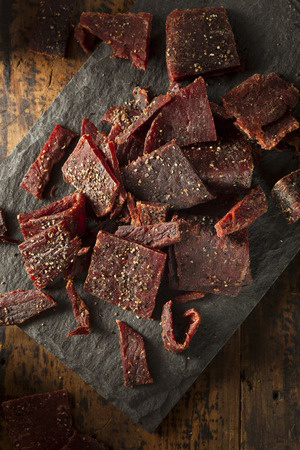 Who knew beef jerky would become a thing?
Who knew beef jerky would become a thing?
Apparently some food marketer somewhere did, because it has. Jerky is big. Really big. And as one of the hottest trends in the food industry, it warrants your attention. Jerky is seemingly everywhere these days. It's in restaurants. It's in natural food stores. There's even a gourmet jerky-of-the-month service.
We've come a long way from the Macho Man Randy Savage manically admonishing consumers to "Step into a Slim Jim" or late-night infomercials waxing uncomfortably ecstatic about Popeil-enabled homemade turkey jerky. But what made jerky so suddenly popular?
Jerky Is No Longer a Byproduct of Meat Processing
Jerky was, at one point, comprised solely of leftovers, shavings and leavings of the packing plant, aggregated and slurried together, doctored up with salt, spices and a wallop of MSG, then sent off to languish on the pony keg shelf. That's all changed.
True, some jerky is still made from parts of animals that would otherwise go to waste. But other jerky products are now made from high-end cuts— tenderloins, filets, prime rib— and from grass-fed Angus beef, free-range chicken, or sustainably-raised pork.
There are exotic variations, too. Bison jerky. Ostrich jerky. Alligator jerky. Yak jerky. If it moos, flies, crawls, runs, swims, or slithers, there's some form of preserved meat snack made out of it. And they're not dried-out, salted-up bundles of scraps with unholy preservatives, either. Jerky makers are increasingly experimenting with bold spices— cracked black peppercorns, turmeric, cumin, allspice, saffron, cinnamon and nutmeg— and herbs like rosemary, sage, cilantro and mint.
"The omnipresent artisanal-food movement has an insatiable appetite for elevated junk foods," Details contributor Kathleen Squires recently noted, "and it assisted beef jerky's migration from truck stop to gourmet supermarket— it's right there, next to the kale chips."
"Now," she wrote, "restaurants are co-opting it, putting jerky on the thousand salumi boardsinspired by nose-to-tail butchery."
Don't believe it? Then check out Brooklynite food critic Keith Wagstaff's review of chef Tom Colicchio's new, gourmet jerky line.
"These are not the tough, dried-out pieces of jerky that require mighty mandible muscles. Each piece is moist yet firm, tearing apart easily," Wagstaff wrote. "You can navigate through a series of options and make your own combo, mixing all-natural marinades, rubs, and glazes with morsels of cayenne, brown sugar, ginger, garlic, honey and tamari."
A Slim Jim? 99 cents, if. A two-ounce custom bag of Colicchio's? Try $10. Quality commands a premium.
As restaurants and snack food companies meet consumers' demand for more variation in the available palette, jerky is a real opportunity. East Asian, South Asian, Mediterranean, Latin American, Caribbean and even good, old-fashion American soul cuisines can all inform a diversified jerky product line.
There are even vegan jerky options out in the market now, for veg-heads who occasionally miss tearing into something carnally chewy and savory.
A Recipe for (Teriyaki Jerky) Success
Mouth watering yet? You obviously haven't made your own jerky at home. And you don't necessarily need a Ronco dehydrator to do it, either.
This five-star-rated teriyaki jerky recipe from Food Geeks, for example, can be made with a regular oven:
INGREDIENTS
3 lb. beef
1-1/2 cup teriyaki sauce
1 tsp. garlic powder
1 tsp. onion powder
1 tsp. ground ginger
1 tsp. salt
1 tbsp. liquid smoke (optional)
1 tbsp. black pepper (optional)
INSTRUCTIONS
1.) Trim all fat, then cut the meat into strips.
2.) Put meat strips in a gallon-size freezer bag and marinate overnight in the refrigerator.
3.) The following day, stretch meat out on paper towels to drain.
4.) Place a sheet of aluminum foil on lower rack (to catch drippings).
5.) Stretch strips over top oven rack.
6.) Set oven at lowest temperature setting. Crack open the oven door to allow moisture to escape.
7.) Drying times vary due to oven differences and meat size. Smaller pieces will be dry in about 2-1/2 hours; larger pieces may take 4-5 hours.
Go For Big, Bold, Savory Quality. And Let Your Imagination Run Wild
There are so many possibilities and opportunities to get wild. You could experiment with different cuts, different types of meat, and a plethora of exotic flavors. Depending on the meat base used, jerky can lend itself well to sweet, spicy, tangy, smoky, herbal, umami, or even citrus tastes.
Jerky may be one of the most exciting trends in the food industry today. There's plenty of room for further innovation. So stop jerking us around. Get cracking so we can keep snacking!







